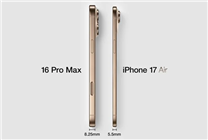Challenges and Innovations Surrounding the iPhone 17 Air: A Closer Look
Summary
- The launch of the iPhone 17 Air is on hold due to eSIM policy restrictions in China.
- Apple has prepared stock for the model, indicating potential launch once policy changes are implemented.
- The iPhone 17 Air features advancements like eSIM technology and a 6.6-inch OLED display but faces battery limitations.
In a recent update, Apple accessory manufacturer and digital blogger “Kang” confirmed that the launch of the iPhone 17 Air has been delayed due to issues surrounding the eSIM policy in China. This development raises questions about the future of the device and its availability in the region.
However, there is optimism on the horizon. Reports suggest that Apple has stock of the iPhone 17 Air ready in China, which indicates that the company is actively engaging with the relevant authorities to address policy concerns. The model is expected to launch immediately once the eSIM policy is finalized.
Furthermore, insights from China Unicom employees reveal that the firm’s headquarters issued a notice regarding the provision of business support for Apple’s eSIM initiatives, which hints at preparations for the new phone’s rollout.
Since the introduction of the iPhone 14 series, Apple has eliminated physical SIM cards in the United States, completely blocking the card slot in favor of eSIM technology. Despite this advancement, global adoption has faced hurdles due to varying regional regulations.
The iPhone 17 Air boasts a design challenge with a 5.5mm ultra-thin body, where the traditional SIM card slot presented a significant barrier to its global launch. This limitation underscores the necessity for eSIM support in certain markets.
eSIM, or embedded SIM technology, allows traditional SIM cards to be integrated directly into devices, eliminating the need for a physical card. This innovation is designed to free up internal space, optimizing design for better functionality.
Yet, despite the elimination of the SIM card slot, the iPhone 17 Air’s battery capacity remains a point of concern, with a mere 3000 milliampere hours, raising questions about its performance during extended use.
On a brighter note, the iPhone 17 Air will feature a 6.6-inch OLED display, capable of supporting a 120Hz ProMotion adaptive refresh rate. This marks a significant first for Apple, as such high-refresh-rate technology has traditionally been reserved for Pro models. This upgrade promises to enhance the user experience dramatically, though it may also put pressure on battery life.
As Apple navigates the complexities of regulatory compliance and consumer expectations, the prospects for the iPhone 17 Air remain cautiously optimistic. Its innovative features combined with the potential for timely market adaptation could redefine user interactions with upcoming devices.
In conclusion, while the road to the iPhone 17 Air’s launch may be bumpy due to eSIM policy constraints, the company’s proactive measures suggest a commitment to overcoming these challenges. As technology continues to evolve, so too will the devices that cater to an increasingly digital world.





